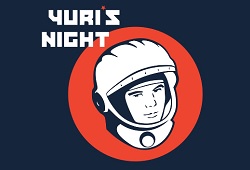
Space… the Final Frontier
For humans, that Final Frontier officially opened on April 12, 1961, when Soviet Cosmonaut Yuri Gagarin became the first person to journey into the realms of outer space and complete an orbit of planet Earth. Although many soon followed – including Americans Alan Shepard and John Glenn – and the likes of Neil Armstrong and Buzz Aldrin reached even greater heights by walking on the Moon, it was Yuri Gagarin who set the stage for those later achievements.
Gagarin died in a plane crash in 1968 but still serves as a source of inspiration for newer generations that believe in the future of space travel. Every year since 2001, these space exploration enthusiasts gather together around the world on the anniversary of Gagarin’s historic flight and celebrate what is now known as Yuri’s Night.
The concept of Yuri’s Night was first conceived in 1999 by Loretta Hidalgo Whitesides, George T. Whitesides, and Trish Garner during the Third United Nations Conference on the Exploration and Peaceful Uses of Outer Space Conference in Vienna. UNISPACE III originally established a World Space Week to be held every October to commemorate the launch of Sputnik 1 and the signing of the UN Outer Space Treaty.
The aforementioned trio believed that celebrating actual human achievements was equally important, and thus launched the first Yuri’s Night on April 12, 2001, in Los Angeles. Other cities joined the fray as well, forming a World Space Party across the globe in the process.
2011 marked the fiftieth anniversary of when humans first entered outer space, and over 100,000 people that year attended 567 Yuri’s Night celebrations in 75 countries, spanning all seven continents. While the 2013 edition may not have been as strong – estimates suggest 351 events in 57 countries – the city of Pittsburgh was among them thanks to the Carnegie Science Center hosting a “sci-fi themed” gathering for the 21-and-over crowd on Yuri’s Night.
The ensuing party included a performance by local indie band Madeline and the Metropolis, a genuine 1981 DeLorean similar to the one used by Marty McFly in Back to the Future, and appearances by the Steel City Ghostbusters. Within the halls of the Carnegie Science Center itself was a two-story, walk-in replica of the International Space Station and the opportunity for attendees to experience life as an astronaut with a 21-foot “zero-gravity” climbing wall.
In many ways, this combination of the fictional and factual was the perfect way to celebrate Yuri’s Night. Human fascination with the possibilities of space travel began with Jules Verne and H.G. Wells and their classic novels From the Earth to the Moon and The First Men in the Moon, both written in the late nineteenth century.
The decade before Yuri Gagarin circled the globe, meanwhile, is often considered the “Golden Age of Science Fiction” with such 1950s films as Forbidden Planet and The Day the Earth Stood Still. Suffice it to say that by the time the 1960s rolled around, multiple generations were ready for the combining of science fiction with science fact as humans finally reached for the stars.
The 1960s also heralded one of the true classics of contemporary science fiction, a television show that paralleled the real life achievements of Gagarin, Shepard, Glenn, and Armstrong. If those pioneers proved that space travel was indeed feasible, it was Gene Roddenberry and Star Trek that showed what the future of space travel, as well as humanity itself, might look like. For Roddenberry, the Cold War rivalry between the United States and Soviet Union would someday be a thing of the past. On the USS Enterprise, Americans and Russians, men and women, humans and aliens of all shapes-and-sizes worked together for the common good.
While Yuri Gagarin, John Glenn, and Neil Armstrong are real life heroes, fictional characters like James T. Kirk and Vulcan science officer Spock likewise served as inspiration for the next generation of scientists, engineers, and space explorers. Exposure to the achievements of NASA and the USS Enterprise – both through the medium of television – melded the real and fictional possibilities for the future into the minds of millions.
In the end, the history of humanity’s exploration of the Final Frontier is rooted in the achievements of Yuri Gagarin as well as the vision of Gene Roddenberry. Before a dream can be reached, after all, someone has to first envision it. That is the true power of Star Trek.
As for the real-world pioneers of the 1960s, by strapping into a tiny tin can and then allowing themselves to be hurled into the darkness of space, they helped open the Final Frontier for each and every one of us.
Anthony Letizia

